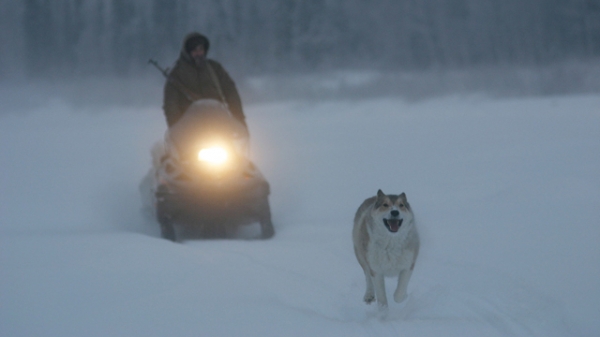Following his films Grizzly Man (2005), Encounters at the End of the World (2007), and Cave of Forgotten Dreams (2010), Werner Herzog presents us with yet another staggering documentary feature in Happy People: A Year in the Taiga.
Deep in the Siberian Taiga, only accessible by boat or helicopter, Gennady, his family and his fellow villagers face some of the most hostile weather conditions on earth. Snow covers the ground for many months, the rivers completely freeze over in temperatures below -50ºc, and winter doesn’t end until May. Yet from August to February, men like Gennady leave their villages and head deep into the wilderness to hunt and trap, with only their dogs for company.
Away from modern distractions and technological trappings, Herzog delivers a romanticised slice of ‘noble savage’ lifestyle. Gennady lives in a hut with no glass over the windows, hand-builds his own traps, and has no human contact for months on end.
Herzog presents this as the ultimate freedom; Gennady and those like him are free from tax, from the government, from telephones, from laws, and are able to live by their own values and behave in a manner that befits their own standards of conduct. Gennady dislikes greed, and despises trappers who kill more than they need to, especially if it’s for money. He treats his skills as a trapper in a prosaic way, as an intricate part of the nature of things, and a continuation of traditional way of life. Gennady impresses the importance of having a skill, and using it so it is not forgotten.
However, Herzog does not explore the negative aspects of living so remotely, so cut off from the rest of society. Times are changing the way of life for the people who live in the Taiga. Gennady receives less money for his catch each season, but everything which he needs to buy is becoming more expensive.
Condensing four hours of Dmitry Vasyukov’s TV documentary, Herzog has cherry picked the most captivating and romantic moments. The dialogue is sparse and matter-of-fact, and Herzog’s narration provides an uplifting, escapist conduit into what we can view as a frozen wonderland, and this is what elevates it above a standard nature documentary. The landscape is vast and breathtaking, seemingly untouched under fresh snowfall. Herzog presents us with Gennady and his dogs sitting next to a fire with a cup of tea, or traversing snowdrifts on homemade skis.
Gennady makes for a solid focus of Happy People, appearing to be the absolute embodiment of Herzog’s themes. He respects the brutality of nature, and says that hunting brings him closer to the Taiga. He’s very attached to his dogs too, which become a major focus in the film. He explains what makes for a good working dog, and how to train it, all the while accompanied by adorable puppies being taken for a ride in a canoe. One of the longest clips of speech is Gennady retelling the death of his best dog, Smokey, at the paws of a bear attack. He shot the bear point blank, and his emotion in this take is touching. It’s something that a Western audience can identify with; we may not provide for our families by hunting in the woods, we may not know how to make a canoe from a tree, but we sure do love our pets.
Happy People is a gateway into a world which we don’t often see represented on film. Herzog gives a romanticised look at a “simpler” way of life, and the feel-good narrative arc buoys the audience’s souls. Beneath the snow and dogs, it’s an interesting documentary, in keeping with Herzog’s enthusiasm for extreme locations and climates, and the people who inhabit them.
Happy People: A Year in the Taiga is released on DVD on November 28 2011






